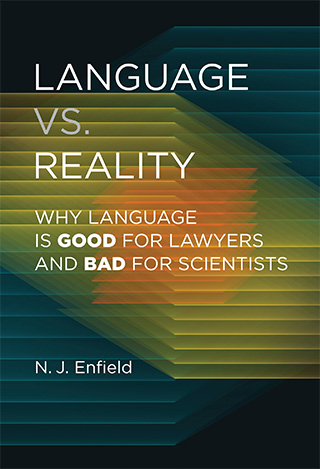How Stories Help Us Make Sense of the World

When I first traveled to the hilltops of central Laos to study the Kri language, I was getting to know members of an entire community. Early in my time living in the village of Mrkaa, I wanted to pay a courtesy visit to as many of the village households as I could. The Kri practice of early-evening tea drinking around home fires gave me the chance to meet people and practice the language that I was learning more formally through the day. Early one evening, I approached the home of Mr. Siangthong and called out: Saaw krnooq tôô ki dêêh? (May I enter?). He replied: Tôô (You may!).
Kri homes are built up high on pylons. To enter, you first have to climb a (usually quite rickety) ladder to get up to floor level. Once you’re on the verandah, there are two doorways into the house, one at each end of the front wall. One doorway, reserved for family, opens into the “inner” half of the house; the other, used by guests and strangers, to the “outer” half of the house. Once you’ve entered the main room of the house, you take a seat on the floor. How far toward the back wall you sit depends on how high your status is in terms of age or rank in the community. Older people, or those with a higher rank, are seated farther toward the back of the room (the “high” side).

Being split along two dimensions, the floor space of the Kri house becomes a map of people’s social statuses. People are seated according to how they socially relate to each other. At least that’s the theory.
I was oblivious to all of this. On that evening, when I entered Siangthong’s house I happened to come in through the inner doorway and take a seat against the lower wall just inside: a place reserved for the lowest of the low, the son-in-law. That’s when Siangthong called out in a joking voice: Vòòk nik tôô matààm (Grandpa Nick is a son-in-law!). People thought this was hilarious, as any in-law joke should be. I was promptly escorted to my rightful place. And for a while, the joke was recounted over and over in the village.
That was the moment I first became aware of the social significance of the Kri house’s floor plan. What would normally go unspoken had to be articulated thanks to my transgression. Siangthong explained to me the social meaning of the house’s spatial layout. He drew my attention to what I had seen every day but had not seen since my arrival in Mrkaa. After that, I saw it every time I looked. Whenever I went into someone’s house, I would see that people were obeying these rules, everyone seated in their proper place.
This was an experience of sense making. Before that evening, I was oblivious to the orderly nature of a piece of social reality that had been in front of me all along. I don’t know how many times I had made the same misstep, blissfully unaware. People were too polite to point it out, at least not while I was present.
What does it mean to make sense of something? When my host joked that I was a son-in-law because of where I sat, I learned a number of things at once. I learned something about the layout of the house. I learned something about the values that people attach to various places where a person might sit. I learned something about Kri sons-in-law and something about my own status in the Kri community. All this knowledge was transmitted through the heightened experience of being the butt of a joke — not traumatic but just heightened enough to be jolted into my memory. After that day, I never made the mistake again.
Unexpected events make stories interesting. Our skin conductance increases. Our heart rate changes. Our blood vessels constrict.
The process of sense making starts with disruption. Something going against the flow. Against expectations. People react with surprise and sanction. And this in turn requires an explanation. Think of how we deal with children’s wayward behavior. It’s not just in Kri houses that there are right and wrong places to sit. If a seven-year-old climbs onto my kitchen table and sits there, this breaks a well-established local norm, and the disruption would give me license to call her out. I might say That’s a table, not a chair. Now notice how the statement does multiple things at once. First, it communicates the fact that there is a problem, a deviation from the norm. Sitting on the table is out of order. Second, it says something specific about what chairs are for and something about what tables are not for. The remark points to several bits of social convention: how we should behave, what certain objects are rightfully for, and what certain words in our language mean. Children are apprentices of sense making, and language is their master key.
Things make sense when we know what we should regard as normal and what we should be surprised at. Indeed, the very possibility of people remarking on something is a measure of how surprising or exceptional (literally, remarkable) it is. Unexpected events make stories interesting. This is even registered in the brain activity that accompanies surprise. Consider this:
I like my coffee with cream and socks.
As you processed that sentence, you were not expecting the word socks. It triggered in your brain an electrical signature of surprise called the N400 effect. At about 400 milliseconds after an unexpected input, there’s a change in the brain’s electrical activity that can be measured on the scalp.
This is not the only physiological effect of surprise. Our skin conductance increases. Our heart rate changes. Our blood vessels constrict. When things go against our expectations, we respond physically. Even minor transgressions of expectation affect us directly, and this helps to explain why we pay attention to them and why, in turn, they have the mutual prominence needed to serve as landmarks in coordination games.
The stories we tell in daily conversations almost always center on disruptions from the normal flow of life. But they aren’t usually the epic disruptions we see in novels and movies. Just about any little departure will do. If something is out of the ordinary, or otherwise seems unlikely, this gives us license to talk about it. The very fact that people are telling a story about something shows that they regard it as out of the ordinary. This is how we learn about social norms. It is how we learn about other people. When people show us what they find remarkable and why, they show us who they are.
If you’re telling me something, it should be news. It wouldn’t be a conversation if I just kept saying the same things. One of the strongest principles that has been discovered about language use by philosophers and psychologists of language is the cooperative maxim in communication: Be relevant. In part, this means: Don’t tell people things that they already know. At each point, what you say should be informative.
Even one-year-old children are tuned into this. Psychologists Tibor Tauzin and György Gergely saw a link between the newness of every move in conversation and the human capacity for “mind reading.” (This doesn’t mean that people can literally read minds. It’s a standard term for our propensity to infer or attribute perceptions, beliefs, and knowledge to other people despite the fact that we have no access to their internal states.) The mind-reading capacity develops in humans from a young age. In fact, children who do not develop this capacity are likely to have difficulty learning language at all. In Tauzin and Gergely’s experiments with one-year-olds, the infants watched a cartoon with two blobs interacting and making simple sounds in an alternating pattern. One group of infants saw “conversations” in which the on-screen blobs made new signals at each turn, mirroring the norm in human conversation. For another group, the blobs exchanged repeated identical signals, not unlike the alternating call exchanges of many animal species. Two marmosets, for example, will exchange the same call (a whistle-like phrase known as a phee call), in alternation, over and over. Imagine people talking like this:
A: Hello, how are you?
B: Good, how are you?
A: Good, how are you?
B: Good, how are you?
A: Good, how are you?
B: Good, how are you?
A: Good, how are you?
B: Good, how are you?
When the infants in Tauzin and Gergely’s experiment observed a computer-animated version of this — where two agents go back and forth making the exact same sound over and over — the infants did not infer that any relevant information was being exchanged. But when the figures on the screen exchanged new and unpredictable signals with each turn, infants would infer that one agent was giving the other agent new information, for some practical purpose. For example, they understood that one partner was telling the other one where a misplaced object could be found.
Imagine a movie about the most ordinary and uneventful day in your life. Would people pay to watch it? No offense, but it seems unlikely. It’s true that a good story often starts on an ordinary day, but it only really begins when that ordinariness is disrupted. In novels and movies, this disruption and the ensuing trouble are often epic, harrowing, and life transforming. Most of us seldom, if ever, go through transformations of the kind we see in screenplays. And this is exactly what gives fictional stories one of their important sense-making functions: Once transported, we get to live someone else’s experience, without the real-life consequences. A good story is a flight simulator for the mind.
This kind of simulation — written by one person, run by another — exploits the fundamental and unique trick of language: the fact that words can inform you about events you cannot witness for yourself. When I tell you, say, what happened on my subway ride this morning, my words are instructions for your imagination, to use linguist Daniel Dor’s phrase. This can be useful for obvious practical reasons. I can tell that it’s raining at our destination, and you will know to carry an umbrella and raincoat. But in the case of fiction, what can you do with the contents of a novel or screenplay? An answer is found in the kinds of thing that fictional stories tend to be about.
The problems that fictional stories depict aren’t just any disruption of norms. They tend to involve personal ordeals, of much greater intensity and scale than we experience in real life.
Take homicide. How likely are you to be murdered? In reality, an example annual estimate — for adults under age 50 in the United States in 1990 — is 15 murders per 100,000 members of the population. That’s a high murder rate in the global context, but it is low in absolute terms: well below a 50th of 1 percent of people are murdered. In novels, the rate is orders of magnitude greater than this. A study of nearly 750 20th-century American novels found a murder rate of 11 percent. That is, one out of 10 people is murdered in those fictional worlds. It’s a thousand times more likely that a person will be murdered in a novel than in real life. Why? Because that’s what readers want. Novels are written for the audiences who will pay for them. The question is: Why do we want to read accounts of killing?
Cognitive scientist Olivier Morin and colleagues sought to explain not only why we like to read about murder and mayhem but also why we enjoy the kind of harrowing and emotional fiction that tragedy presents:
Fictional narrative primarily simulates “ordeals”: situations where a person’s reaction might dramatically improve or decrease her fitness, such as deadly aggressions, or decisions on long-term matrimonial commitments. Experience does not prepare us well for these rare, high-stakes occasions, in contrast with situations that are just as fitness-relevant but more frequent (e.g., exposure to pathogens).
Other researchers have converged on the story-as-simulator idea, arguing that stories allow us to vicariously live through experiences we might not want to undergo ourselves. By following stories about the dramatic and the dangerous, we train, develop, and hone our social, emotional, and cognitive skills, and we prepare for real-world encounters and possible futures.
If stories are simulations, language itself is the raw material that makes such simulation possible.
Words can tell us about places other than the here and now. They present us with situations we haven’t experienced and may never experience. One reason we read fiction, said literary critic Harold Bloom, is “because we cannot know enough people.” If stories are simulations, language itself is the raw material that makes such simulation possible.
Another way we learn through language is from explanation. Society is built on the passing on of knowledge about our inventions, ideas, tools, and techniques. It might seem that we can transmit know-how without using words — for example, by simply letting people watch how we do something — but even then we use words to define what we’re showing, to frame it by specifying its purpose, to draw attention to what we want people to notice, to point to what’s happening, where, and why. A friend might explain how a new app works. I might teach my daughter how to use an abacus. You might show me the difference between a major and a minor chord on the guitar. Language will always be involved.
Simple acts of explaining or informing can have purely practical goals. I tell you how to use this app so you can use it later on your own. I show you this chord so you can play that song you’re learning. But often, practical advice is embedded in fiction-style narrative. This makes the advice more engaging and easier to understand and remember. For example, stories about natural phenomena can help us make sense of our environment, and can also pass on important practical wisdom. In one Japanese folk tale, an old man, tending his rice fields up high on a mountain, sees the sea recede and a tsunami approaching; he sets fire to his house and the fields to warn the villagers below. They rush to help put out the fire and escape the tsunami which destroys their village.
Coastal peoples around the world have similar tsunami tales. The stories recount world-altering events in a group’s collective past as well as lifesaving information for later generations. People who know the Japanese folk tale know to run to higher ground if the sea recedes. The Moken people of the west coast of Thailand near the Thailand/Myanmar border say that “one day the navel of the sea would suck all water and spit it all back in the form of waves. Many people would die.” Put this way, the story has a fantastical element, but it still accurately describes a feature of tsunami events: the sea receding far into the distance before returning to wash over the land in the most terrifying and destructive way.
Folk tales like this are said to have saved lives during the tsunami of late 2005 that hit Thailand, Indonesia, Sri Lanka, and the Nicobar and Andaman Islands. Similar stories are heard in Aboriginal Australia, Sri Lanka, the Northwest Pacific region of North America, and New Zealand.
Many Australian Aboriginal groups have myths and legends about great floods, dating back 7,000 years, that tell of a time when the former coastline of mainland Australia was inundated by rising sea level. These flood stories capture the imagination. Like the tsunami stories, they combine great drama with causal explanation and add to people’s understanding of their environment. And again like the tsunami stories, these stories may transmit knowledge that could help avoid potential dangers. This individually possessed knowledge is also collective knowledge.
The Australian flood stories are grounded in real events. They align with independent paleogeographic evidence about historical changes in sea levels and associated flooding. But there are of course many cultural origin stories that do not concur with known scientific evidence or that may seem more far-fetched, metaphors at best. Here are two stories that I have heard about the deep history of the people I work with in upland Laos.
The Kri have no alphabet or other system for writing their language. Why not?
Once upon a time, the Kri had a way of writing their language down. But they had no paper. Instead, they wrote on buffalo hides. One day, dogs ate the hides and the writing was lost forever. That is why, today, Kri speakers have no way of writing their language.
The Kri have a set of cultural prohibitions that are regarded as stricter than any of the many ethnic groups in their area. For example, traditionally, they don’t eat any red meat at all, only fish. Why is this?
Once upon a time, a tiger went to the water to find something to eat. It found a clam which opened up and said “Come here Tiger, put your tongue in here and eat me up.” Suddenly, the clam shut its shell tight on the tiger’s tongue. The tiger walked to a nearby Kri village to ask for help. The villagers just laughed and said “It serves you right!”, and sent the tiger on its way. The tiger went to another village, of a different ethnic group, where villagers helped it to release the clam. The tiger returned to the Kri village. “You didn’t help me. In return for that, from now on you have to follow these strict taboos. If you don’t, I will attack you and eat you.”
This story is offered to explain why, from then on, Kri villagers have had to abide by stricter cultural prohibitions than other groups in the area.
It doesn’t matter if these stories aren’t true. It doesn’t even matter if people don’t really believe them. What matters is that people coordinate around them — that the stories are told and heeded. The sharing of stories through language can be a goal in itself. They are landmarks for shared attention and for shared identity. The stories work because we agree to treat them as ours; they identify us and explain things about us.
When we say that language plays an important role in sense making, this refers only partly to the process of making sense in an individual’s mind. Most importantly, it establishes shared points of reference for sense making among members of a community, or at the very least, people who have some relationship to each other. Seen this way, the things we say — whether or not they convey true information — are attempts to publicly establish those points of reference. This is what language is good for. Of course, we often use language for informing people of things. And there will often also — or alternatively — be more strategic motivations. But whatever your reasons, simply by using some words and not others, you are always making a claim to set the agenda for what we should coordinate around.
N. J. Enfield is Professor of Linguistics at the University of Sydney and Director of the Sydney Centre for Language Research. He is the author of, among other books, “The Anatomy of Meaning,” “The Utility of Meaning,” “How We Talk,” and “Language vs. Reality,” from which this article is adapted.



